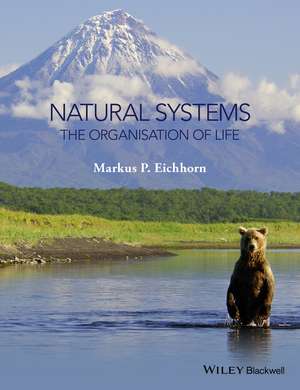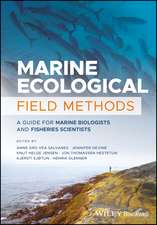Natural Systems – The Organisation of Life
Autor M Eichhornen Limba Engleză Paperback – 28 apr 2016
Preț: 442.48 lei
Preț vechi: 574.64 lei
-23% Nou
Puncte Express: 664
Preț estimativ în valută:
84.67€ • 88.40$ • 70.07£
84.67€ • 88.40$ • 70.07£
Carte tipărită la comandă
Livrare economică 05-19 aprilie
Preluare comenzi: 021 569.72.76
Specificații
ISBN-13: 9781118905920
ISBN-10: 111890592X
Pagini: 392
Dimensiuni: 192 x 245 x 20 mm
Greutate: 0.91 kg
Editura: Wiley
Locul publicării:Chichester, United Kingdom
ISBN-10: 111890592X
Pagini: 392
Dimensiuni: 192 x 245 x 20 mm
Greutate: 0.91 kg
Editura: Wiley
Locul publicării:Chichester, United Kingdom
Public țintă
Senior undergraduate student and graduate students of community ecology, biodiversity, biogeography, ecosystem studies, and conservationCuprins
Preface xv Acknowledgements xix Abbreviations xxi 1 Introduction: defining nature 1 1.1 How little we know 1 1.2 Pressing questions 2 1.3 The hierarchy of nature 2 1.4 Biodiversity 4 1.5 Myths to bust 4 1.6 Further information 5 1.6.1 Recommended reading 5 References 5 Part I: Species 2 What is a species? 9 2.1 The big question 9 2.2 Species concepts 10 2.2.1 Nominalistic 10 2.2.2 Morphological 11 2.2.3 Biological 12 2.2.4 Phylogenetic 13 2.2.5 Genetic 14 2.3 Solving the riddle 16 2.4 Coda: Species richness 17 2.5 Conclusions 17 2.5.1 Recommended reading 17 2.5.2 Questions for the future 17 References 17 3 The history of life 19 3.1 The big question 19 3.2 Sources of evidence 19 3.2.1 The fossil record 19 3.2.2 Molecular evidence 20 3.3 A brief history of diversity 20 3.4 Uneven diversity 24 3.5 Conclusions 25 3.5.1 Recommended reading 26 3.5.2 Questions for the future 26 References 26 4 How many species are there? 29 4.1 The big question 29 4.2 How can we not know? 29 4.3 Discovery rates 30 4.4 Scaling 32 4.5 Sampling-based methods 33 4.6 Other organisms 36 4.7 Wrapping up 36 4.8 Conclusions 37 4.8.1 Recommended reading 38 4.8.2 Questions for the future 38 References 38 Part II: Diversity 5 Measuring diversity 43 5.1 The big question 43 5.2 Scales of diversity 43 5.3 Species richness 43 5.4 Believing in estimates 46 5.5 A SAD story 47 5.6 Diversity of species 49 5.7 Other measures of diversity 51 5.8 beta diversity 53 5.9 Case study: The Binatang project 54 5.10 Conclusions 57 5.10.1 Recommended reading 57 5.10.2 Questions for the future 57 References 57 6 Niches 61 6.1 The big question 61 6.2 Historical background 61 6.3 Back to basics 63 6.4 Birth and death rates 63 6.5 The ZNGI 66 6.6 Impact vectors 67 6.7 Supply points 67 6.8 Coexistence 68 6.9 The evidence 71 6.10 Implications 73 6.11 Conclusions 76 6.11.1 Recommended reading 77 6.11.2 Questions for the future 77 References 77 7 Patterns in species richness 79 7.1 The big question 79 7.2 Area 79 7.3 Local and regional species richness 81 7.4 Local patterns in species richness 85 7.4.1 Elevation 85 7.4.2 Depth 88 7.4.3 Peninsulas and Bays 88 7.4.4 Isolation 89 7.4.5 Mid-Domain Effects 89 7.5 Congruence 89 7.6 Assembling a model 90 7.7 Conclusions 91 7.7.1 Recommended reading 91 7.7.2 Questions for the future 92 References 92 8 Drivers of diversity 95 8.1 The big question 95 8.2 Coexistence or co-occurrence? 95 8.3 Energy and resources 95 8.4 Diversity begets diversity 101 8.4.1 Heterogeneity in space 101 8.4.2 Heterogeneity in time 103 8.5 Disturbance 104 8.6 Top-down control 105 8.7 Expanding our model 109 8.8 Conclusions 110 8.8.1 Recommended reading 110 8.8.2 Questions for the future 111 References 111 9 Does diversity matter? 113 9.1 The big question 113 9.2 Ecosystems 113 9.3 What shape is the relationship? 115 9.4 Field experiments 117 9.5 Other measures of diversity 121 9.6 Multifunctionality 122 9.7 The real world 125 9.8 Species richness and productivity 126 9.9 Conclusions 127 9.9.1 Recommended reading 127 9.9.2 Questions for the future 128 References 128 Part III: Communities 10 Organisation at the community scale 133 10.1 The big question 133 10.2 Definitions 133 10.3 Communities in the field 134 10.4 Quantitative approaches 135 10.5 Community structure 137 10.6 Food chains 140 10.7 Food webs 142 10.8 Complexity and stability 145 10.9 Trophic cascades 147 10.10 SAD again 148 10.11 Complex systems 151 10.12 Unified neutral theory 153 10.13 Metabolic theory of ecology 155 10.14 Conclusions 156 10.14.1 Recommended reading 157 10.14.2 Questions for the future 157 References 157 11 Stability 161 11.1 The big question 161 11.2 Stable states 161 11.3 Changing environments 164 11.4 Hysteresis 165 11.5 Predicting changes 167 11.6 Coral reefs 169 11.7 Shifting baselines 170 11.8 Conclusions 173 11.8.1 Recommended reading 174 11.8.2 Questions for the future 175 11.9 Coda: the seduction of Gaia 175 References 176 12 Changes through time 179 12.1 The big question 179 12.2 Succession 179 12.3 Succession and niche theory 180 12.4 Examples of succession 182 12.5 Disturbance 184 12.6 Modelling succession 185 12.7 Regeneration 187 12.8 Plants and animals 188 12.9 Case study: Mpala, Kenya 188 12.10 Conclusions 190 12.10.1 Recommended reading 190 12.10.2 Questions for the future 190 References 191 13 Changes through space 193 13.1 The big question 193 13.2 Community assembly 193 13.2.1 Competitive exclusion 194 13.2.2 Historical processes 196 13.2.3 Habitat checkerboards 197 13.2.4 Chance and contingency 198 13.3 Metacommunities 199 13.4 Dispersal limitation 204 13.5 Combining environment and dispersal 208 13.6 Conclusions 210 13.6.1 Recommended reading 210 13.6.2 Questions for the future 210 References 210 Part IV: Biogeography 14 Global patterns of life 215 14.1 The big question 215 14.2 Biogeography 215 14.3 Phytogeography 217 14.4 Ecoregions 222 14.5 Empirical approaches 223 14.6 The oceans 225 14.7 Fresh water 228 14.8 Conclusions 228 14.8.1 Recommended reading 229 14.8.2 Questions for the future 229 References 229 15 Regional species richness 233 15.1 The big question 233 15.2 Climate and productivity 234 15.3 Other processes 236 15.4 Scale and productivity 238 15.5 Latitudinal gradients 240 15.6 Centres of origin 243 15.7 Regional species-area relationships 244 15.8 Confounding effects 244 15.9 Conclusions 245 15.9.1 Recommended reading 246 15.9.2 Questions for the future 246 References 246 16 Latitudinal gradients 249 16.1 The big question 249 16.2 Hypotheses 249 16.3 Geographic area 249 16.4 Climatic stability 251 16.5 Productivity 252 16.6 Niche size 253 16.7 Evolutionary speed 254 16.8 Out of the tropics 257 16.9 Conclusions 261 16.9.1 Recommended reading 262 16.9.2 Questions for the future 262 References 262 17 Earth history 265 17.1 The big question 265 17.2 Geological history 265 17.3 Continental drift 266 17.4 Echoes of Pangæa 269 17.5 Climatic effects 272 17.6 Ice ages 274 17.7 Sea level 278 17.8 Extinctions 278 17.9 Conclusions 281 17.9.1 Recommended reading 283 17.9.2 Questions for the future 283 References 283 18 Dispersal 287 18.1 The big question 287 18.2 Range expansion 287 18.3 Mechanisms of dispersal 289 18.4 Barriers 290 18.5 Case studies 292 18.5.1 New Zealand 292 18.5.2 Madagascar 295 18.6 Conclusions 299 18.6.1 Recommended reading 300 18.6.2 Questions for the future 300 References 300 19 Life on islands 303 19.1 The big question 303 19.2 Types of island 303 19.3 Island biotas 305 19.4 Evolution of endemics 305 19.5 Size changes 307 19.6 Reproduction and dispersal 310 19.7 Super-generalists 311 19.8 Endemic communities 312 19.9 Disharmony 312 19.10 Assembly rules 314 19.11 Island species richness 314 19.12 The equilibrium model of island biogeography 317 19.13 Testing the theory 319 19.14 Conclusions 320 19.14.1 Recommended reading 320 19.14.2 Questions for the future 320 References 320 20 Reinventing islands 323 20.1 The big question 323 20.2 A critique of EMIB 323 20.3 Rival hypotheses 326 20.4 Disturbance 326 20.5 Relaxation 329 20.6 Extinctions 331 20.7 Invasions 331 20.8 A new theory? 332 20.9 Evolution 333 20.10 Conclusions 338 20.10.1 Recommended reading 338 20.10.2 Questions for the future 338 References 338 21 What is a natural system? 341 21.1 The big question 341 21.2 Lessons learnt 342 21.2.1 Ecological processes are scale dependent 342 21.2.2 All interactions are nested 342 21.2.3 There is no such thing as the balance of nature 342 21.2.4 Everything is contingent 343 21.3 Processes not systems 343 References 344 Appendix A Diversity analysis case study: Butterfly conservation in the Rocky Mountains 345 A.1 Software resources 345 A.2 Calculations 346 A.3 Synthesis 350 A.4 Conclusions 351 References 352 Glossary 353 Index 359
Descriere
Organised into four sections, this text discusses the organisation of the living world.


















